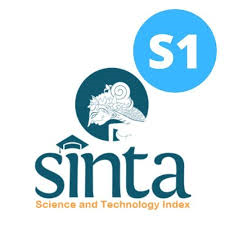BAMBOO RESOURCES, CULTURAL VALUES, AND EX-SITU CONSERVATION IN BALI, INDONESIA
Abstract
Keywords
Full Text:
PDFReferences
ARINASA, I. B. K. & PENENG, I. N. 2013. Jenis-jenis Bambu di Bali dan Potensinya. LIPI Press, Jakarta.
ARINASA, I. B. K. & SUJARWO, W. 2015. The diversity of endemic bamboo in Bali and conservation efforts.Bamboo Journal 29: 85–92.
ASTUTI, I. P. & ARINASA, I. B. K. 2002. Traditional bamboo charcoal in Bali, Indonesia.Bamboo Journal 19: 53–59.
BADAN PUSAT STATISTIK. 2015. Bali Dalam Angka 2015. Badan Pusat Statistik Press,Denpasar.
DRANSFIELD, J. 1981. The Biology of Asiatic rattans in relation to the rattan trade and conservation. In: SYNGE, H. The Biological Aspects of Rare Plant Conservation. John Wiley & Sons Ltd., London. Pp. 179–186.
DRANSFIELD, S. & WIDJAJA, E. A. 1995.Plant Resources of South-East Asia 7: Bamboos.Backhuys Publishers, Leiden.
GIRMANSYAH, D., SANTIKA, Y., RETNOWATI, A., WARDANI, W., HAERIDA, I., WIDJAJA, E.A. & VAN BALGOOY, M.M.J. 2013. Flora of Bali: An Annotated Checklist. Yayasan Pustaka Obor, Jakarta.
http://www.kebunrayabali.com. Accessed 16 June 2015.
http://www.bamboocentral.org. Accessed 26 September 2015.
http://www.theplantlist.org. Accessed 12 March 2018.
LUGRAYASA, I. N, WARNATA, I. W. & ARINASA, I. B.K. 2009. An Alphabetical List of Plant Species Cultivated in Eka Karya Bali Botanic Garden Catalogue. LIPI Press, Jakarta.
PRINGLE, R. 2004. A Short History of Bali:Indonesia’s Hindu Realm. Allen and Unwin, Crows Nest.
QING, Y., ZHU-BIAO, D., ZHENG-LIANG, W.,KAI-HONG, H. E., QI-XIANG, S. & ZHENHUA, P. 2008. Bamboo resources, utilization and ex-situ conservation in Xishuangbanna, South-eastern China. J. Forestry Res. 19: 79–83.
SHARMA, M. L. 1980. Bamboos in the Asia-Pacific Region. In: LESSARD, G. (Ed.). Bamboo Research in Asia. IDRC, Ottawa. Pp.99–120.
SIMMONDS, N. W. 1976. Evolution of Crop Plants. Longman Scientific & Technical, Essex. SODERSTROM, T. R. & CALDERON, C. E. 1979. A commentary on the bamboos. Biotropica 11: 161– 172.
SUJARWO, W. 2010a. Potential use of bamboo as medicine in Bali, Indonesia. Magazine of the American Bamboo Society 31(2): 10–12.
SUJARWO, W. 2010b. Indigenous knowledge on Gigantochloa hasskarliana in Karangasem District, Bali, Indonesia. Magazine of the American Bamboo Society 31(3): 10–12.
SUJARWO, W., ARINASA, I. B. K. & PENENG,I. N. 2010a. Inventarisasi jenis-jenis bambu yang berpotensi sebagai obat di Kabupaten Karangasem Bali. Buletin Kebun Raya 13(1): 28–34.
SUJARWO, W., ARINASA, I. B. K. & PENENG, I. N. 2010b. Potensi bambu tali (Gigantochloa apus Schult & Kurz) sebagai obat di Bali. Buletin Penelitian Tanaman Rempah dan Obat 21: 129–137.
SUJARWO, W. 2011. Penjor: One tool of Hindus religious ceremonies at Galungan feast in Bali.Magazine of the American Bamboo Society 32(1): 6–7.
SUJARWO, W. 2012. History and folklore in Bali. Magazine of the American Bamboo Society 33(5): 9–11.
SUJARWO, W., ARINASA, I. B. K. & PENENG, I. N. 2012. Inventory and conservation of bamboos with medicinal properties in Buleleng district in Bali Indonesia. Bamboo Journal 28: 47–55.
SUJARWO, W., ARINASA, I. B. K., SALOMONE, F., CANEVA, G. & FATTORINI, S.2014. Cultural erosion of Balinese indigenous knowledge of food and nutraceutical plants. Economic Botany 68: 426–437.
SUJARWO, W. 2015a. How cheap to get bamboo shoots in traditional markets in Bali (Indonesia). Magazine of the American Bamboo Society 36(2): 6–7.
SUJARWO, W. 2015b. Do the bamboo forests create a new spring. Magazine of the American Bamboo Society 36(2): 7–8.
SUJARWO, W. & CANEVA, G. 2015. Ethnobotanical study of cultivated plants in home gardens of traditional villages in Bali (Indonesia). Human Ecology 43: 769-778.
SUJARWO, W. & CANEVA, G. 2016. Using quantitative indices to evaluate the cultural importance of food and nutraceutical plants:Comparative data from the Island of Bali (Indonesia). Journal of Cultural Heritage 18: 342–348.
SUJARWO, W. 2016. Stand biomass and carbon storage of bamboo forest in Penglipuran traditional village, Bali (Indonesia). Journal of Forestry Research 27(4): 913–917.
TAKHTAJAN, A. 1986. The Floristic Region of the World. University of California Press, California.
TENGAH, I. G. P., ARKA, I. W., SRITAMIN, N. M., GOTAMA, I. B. K. & SIHOMBING, H. (1995). Studi Tentang: Inventarisasi, Determinasi dan Cara Penggunaan Tanaman Obat pada “Lontar Usada” di Bali. Puslitbang Farmasi Balitbang Kesehatan Departemen Kesehatan Republik Indonesia, Jakarta.
WIDJAJA, E. A. 2001. Identikit Jenis-jenis Bambu di Kepulauan Sunda Kecil. LIPI Press, Jakarta.
WIDJAJA, E. A., ASTUTI, I. P., ARINASA, I. B. K. & SUMANTERA, I. W. 2005. Identikit Bambu di Bali. LIPI Press, Jakarta.
WONG, K. M. 2004. Bamboo the Amazing Grass: A guide to the Diversity and Study of Bamboos in Southeast Asia. IPGRI and University of Malaya, Kuala Lumpur.
Refbacks
- There are currently no refbacks.









